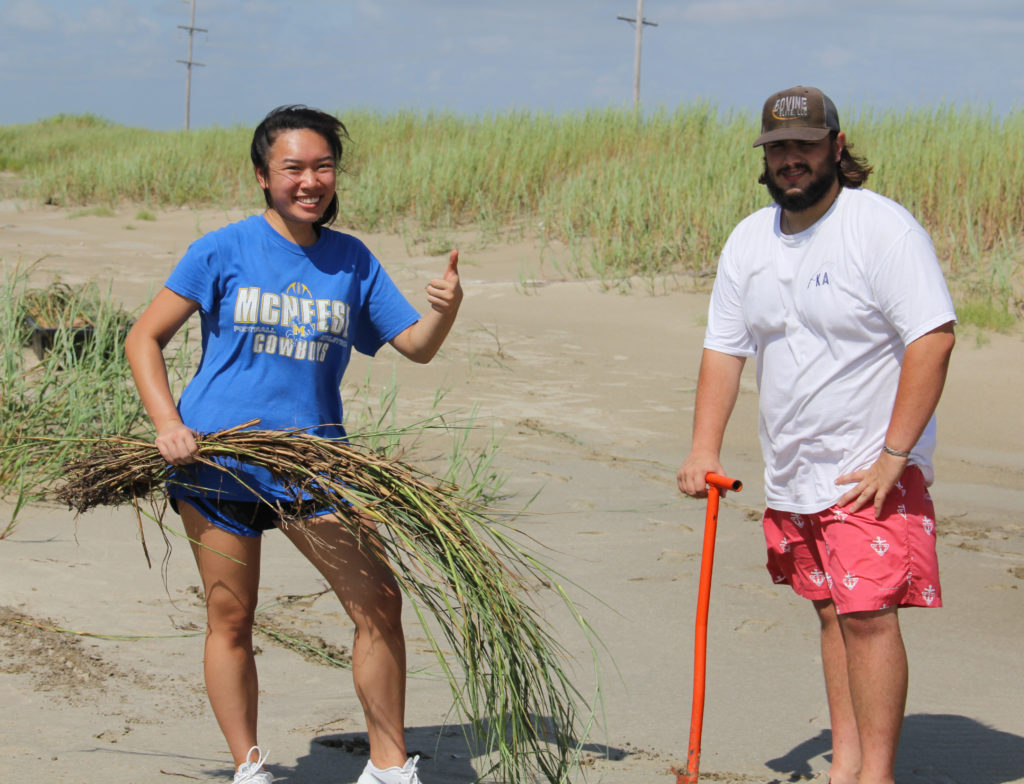
CRCL’s Native Plants Program
Founded in 2000, CRCL’s Native Plants Program (NPP), leads our efforts to restore Louisiana’s coastal habitats by engaging volunteers and stakeholders to be a part of the solution. Our partnerships and events facilitate environmental stewardship by Louisiana industries, landowners, business leaders, residents and visitors.
The NPP provides valuable educational experiences for its volunteers. Participants learn about our coastal land loss crisis, its main causes and the various solutions being implemented across the entire Louisiana coast.
Since its creation, the NPP has engaged more than 15,000 volunteers and directly restored more than 4,500 acres of coastal wetlands in Louisiana.
1,000,000+
plants in the ground since 2007
Restoration Across the State
Visit each restoration project we’ve completed since our habitat restoration work began over 15 years ago. From restoring beaches in Cameron Parish to planting marsh grass in Venice, our volunteers have traveled the state to help restore Louisiana’s coast. Click below to learn more!


Dune Grass Plantings
Our volunteers plant native dune grasses on beaches in southwest Louisiana. These plants encourage sand dunes to form. The resulting dune habitat buffers the area from storm surge, protects inland communities and provides critical wildlife habitat. CRCL typically holds annual beach dune grass plantings in the early or late summer.
Sand habitat is vanishing in southwest Louisiana because of sea level rise, storms and beach development. Sand dunes formed from vegetation act as strong barriers to storms and tides, but without this vegetation, the dunes lack an anchor and will easily erode.
CRCL often plants a native dune grass called bitter panicum (panicum amarum). Bitter panicum has a high salt tolerance, so it’s a great plant for sand dune/beach restoration.
Dune grass acts like a net to catch blowing sand that slowly accretes to form dunes. The plants’ roots also hold sand in place, keeping it from washing away easily. These grasses also have rhizomes —underground stems that grow horizontally through the soil — that anchor the plants and extend through the sand dunes, allowing new stems to “shoot out” across the dunes.
Marsh Grass Plantings
Our volunteers plant native marsh vegetation in fresh to brackish marsh areas that are being restored. This helps create dense root systems that stabilize the soil, capture sediment and minimize storm surge. CRCL’s marsh grass planting volunteer events are usually held in the late spring and early fall.
In addition to stabilizing coastal soils and reducing land loss, marsh grass provides important fish and wildlife habitat. Under natural conditions in marshes, vigorous stands of marsh grass will absorb wave energy and screen suspended solids from intertidal waters. We often plant smooth cordgrass (Spartina alterniflora), marshhay cordgrass (Spartina patens) and California bulrush (Schoenoplectus californicus). Smooth cordgrass, the dominant emergent grass species found growing along tidal salt marshes of the Gulf Coast, is used extensively for erosion control.
The return of the natural hydrology of the areas where we plant is helping improve the reproduction and recruitment of native grasses.


Tree Plantings
Our volunteers plant trees in coastal forests (such as cypress-tupelo swamp) to help reduce effects of storm surge and flooding, as well as improve water quality and create habitat for fish and wildlife. Coastal forests across Louisiana’s coast offer protection from hurricanes and safeguard our communities. Tree planting events are usually held in the late fall and winter.
CRCL often plants bald cypress (Taxodium distichum), red swamp maple (Acer rubrum), and water tupelo (Nyssa aquatica) for coastal forest restoration projects. The native trees that our volunteers plant will grow dense root systems that help hold the sediment in place, encourage land growth and reduce the impacts of subsidence. Restoring these swamp habitats helps to ease the burden on our levees from storm surge energy and protect the surrounding communities. The return of the area’s natural hydrology through larger restoration efforts is improving the reproduction and recruitment of the native trees we plant.
We recently began growing our own bald cypress from seed. Help us gather seeds!
You can help save Our Coast
You can make a difference on our coast! Spend a day with us in the marsh, on the beach or in the forest by volunteering with our Native Plants Program. Only with your help can we accomplish hands-on restoration across the state.


Growing Trees from locally harvested Seeds
In 2022, CRCL began growing bald cypress and mangroves from seed at our Restoration Headquarters in St. Bernard Parish. We are now growing hundreds of trees on site. We host seasonal seed drives, where you can deliver your locally-harvested seeds to be propagated and planted along Louisiana’s Coast.
Additional support for our projects is provided by:
Apache Corporation • Atakapa/Ishak-Chawasha of Grand Bayou Indian Village •
Cheniere Energy • Coastal Protection and Restoration Authority • HDR Foundation • NextEra Energy Foundation • NOAA • Phillips 66
Restore America’s Estuaries • TC Energy •

Requests for proposals
Your company can be part of the work to restore our coast. We’ll share more about our needs here.
